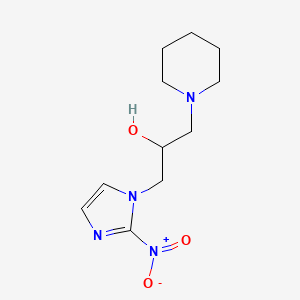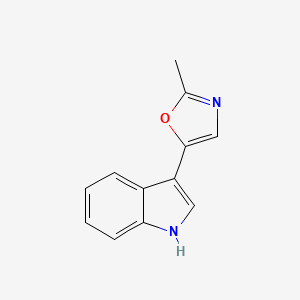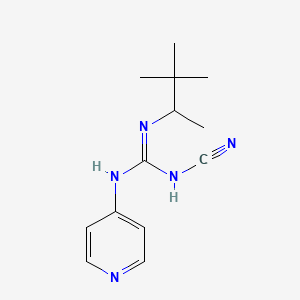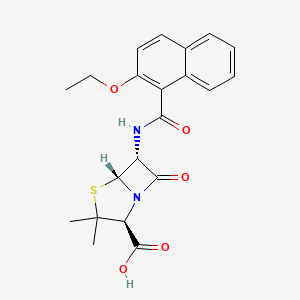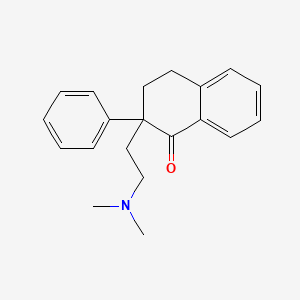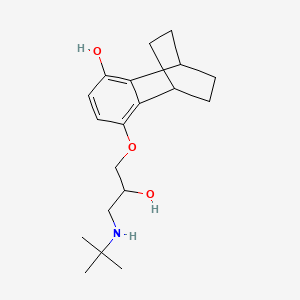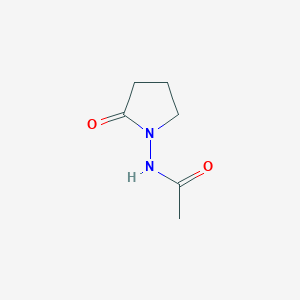
Piracétam
Vue d'ensemble
Description
Le Piracétam est un médicament nootropique appartenant au groupe des racétames, dont le nom chimique est 2-oxo-1-pyrrolidine acétamide. Il s'agit d'un dérivé cyclique du neurotransmetteur acide gamma-aminobutyrique (GABA). Le this compound a été commercialisé pour la première fois par UCB Pharma en 1971 et est connu pour ses propriétés cognitives. Il est utilisé dans divers troubles cognitifs, vertiges, myoclonies corticales, dyslexie et drépanocytose .
Mécanisme D'action
Target of Action
Piracetam is a cyclic derivative of the neurotransmitter γ-aminobutyric acid (GABA) and shares the same 2-oxo-pyrrolidone base structure with pyroglutamic acid . Its mechanism of action differs from that of endogenous gaba .
Mode of Action
Piracetam’s mode of action involves modulation of neurotransmitters, enhanced brain metabolism, improved blood flow, neuroprotection, and facilitation of neuronal communication . It also has effects on the vascular system by reducing erythrocyte adhesion to the vascular endothelium, hindering vasospasms, and facilitating microcirculation .
Biochemical Pathways
Piracetam has been found to inhibit the PI3K/Akt/mTOR pathway in OGD-stimulated SH-SY5Y cells . This pathway is involved in cell cycle regulation and is often dysregulated in diseases
Applications De Recherche Scientifique
Piracetam has a wide range of scientific research applications:
Chemistry: Used as a model compound for studying the properties of cyclic amides and their derivatives.
Biology: Investigated for its effects on cell membrane fluidity and neuroprotection.
Medicine: Used in the treatment of cognitive disorders, myoclonus, and sickle cell anemia. It has also been studied for its potential benefits in conditions like dementia, vertigo, and dyslexia.
Industry: Utilized in the development of nootropic supplements and cognitive enhancers .
Analyse Biochimique
Biochemical Properties
Piracetam interacts with various enzymes, proteins, and other biomolecules. It shares the same 2-oxo-pyrrolidone base structure with pyroglutamic acid and is a cyclic derivative of the neurotransmitter γ-aminobutyric acid (GABA) . Its mechanism of action differs from that of endogenous GABA . Piracetam has neuroprotective and anticonvulsant properties and is reported to improve neural plasticity .
Cellular Effects
Piracetam has significant effects on various types of cells and cellular processes. It enhances the growth of cells, inhibits oxidative stress, and improves mitochondrial function . It influences cell function by modulating neurotransmission in a range of transmitter systems, including cholinergic and glutamatergic systems .
Molecular Mechanism
Piracetam exerts its effects at the molecular level through various mechanisms. It influences neuronal and vascular functions by restoring cell membrane fluidity . This mechanism of action is thought to improve membrane stability, allowing the membrane and transmembrane proteins to maintain and recover the three-dimensional structure or folding for normal function .
Temporal Effects in Laboratory Settings
Piracetam shows changes in its effects over time in laboratory settings. It has been observed that piracetam increases regional cerebral blood flow . This suggests that piracetam might have long-term effects on cellular function observed in in vitro or in vivo studies .
Dosage Effects in Animal Models
The effects of piracetam vary with different dosages in animal models. For instance, daily piracetam treatment at doses of 0, 75, 150, and 300 mg/kg ip was initiated in 6-week-old male mice. The study found that low doses of piracetam reduced search time in the visible-platform component, while all piracetam doses prevented trial-related improvements in performance .
Metabolic Pathways
Piracetam is involved in various metabolic pathways. It has been shown to alter the physical properties of the plasma membrane by increasing its fluidity and protecting the cell against hypoxia . It also increases red cell deformability and normalizes the aggregation of hyperactive platelets .
Transport and Distribution
Piracetam is transported and distributed within cells and tissues. After oral ingestion, piracetam is rapidly absorbed with a bioavailability of 100%. Its volume of distribution is 0.6 L/kg and plasma protein binding is 0% .
Subcellular Localization
It is known that piracetam influences neuronal and vascular functions by restoring cell membrane fluidity . This suggests that piracetam might have specific targeting signals or post-translational modifications that direct it to specific compartments or organelles.
Méthodes De Préparation
Voies de synthèse et conditions réactionnelles
Le Piracétam peut être synthétisé par plusieurs méthodes. Une méthode courante implique la réaction de la 2-pyrrolidone avec le chloroacétate d'éthyle en présence d'une base, suivie d'une hydrolyse pour produire le this compound. Une autre méthode implique la cyclisation de l'acide gamma-aminobutyrique (GABA) avec l'anhydride acétique .
Méthodes de production industrielle
La production industrielle du this compound implique généralement une synthèse à grande échelle utilisant les méthodes mentionnées ci-dessus. Le processus est optimisé pour un rendement et une pureté élevés, garantissant que le produit final répond aux normes pharmaceutiques. Le processus de production comprend des étapes telles que la cristallisation, la filtration et le séchage pour obtenir le composé pur .
Analyse Des Réactions Chimiques
Types de réactions
Le Piracétam subit diverses réactions chimiques, notamment :
Oxydation : Le this compound peut être oxydé pour former de l'acide 2-pyrrolidone-5-carboxylique.
Réduction : La réduction du this compound peut produire de la 2-pyrrolidone.
Substitution : Des réactions de substitution peuvent se produire au niveau du groupe acétamide, conduisant à la formation de divers dérivés
Réactifs et conditions courantes
Oxydation : Les agents oxydants courants comprennent le permanganate de potassium et le peroxyde d'hydrogène.
Réduction : Des agents réducteurs tels que l'hydrure de lithium et d'aluminium peuvent être utilisés.
Substitution : Des réactifs comme les halogénoalcanes et les chlorures d'acyle sont couramment utilisés pour les réactions de substitution
Principaux produits formés
Oxydation : Acide 2-pyrrolidone-5-carboxylique
Réduction : 2-pyrrolidone
Substitution : Divers dérivés d'acétamide
Applications de recherche scientifique
Le this compound a une large gamme d'applications de recherche scientifique :
Chimie : Utilisé comme composé modèle pour étudier les propriétés des amides cycliques et de leurs dérivés.
Biologie : Étudié pour ses effets sur la fluidité des membranes cellulaires et la neuroprotection.
Médecine : Utilisé dans le traitement des troubles cognitifs, de la myoclonie et de la drépanocytose. Il a également été étudié pour ses avantages potentiels dans des conditions comme la démence, les vertiges et la dyslexie.
Industrie : Utilisé dans le développement de compléments nootropiques et de stimulants cognitifs .
Mécanisme d'action
Le mécanisme d'action du this compound n'est pas entièrement compris, mais on pense qu'il implique plusieurs voies :
Modulation des neurotransmetteurs : Le this compound module la neurotransmission dans les systèmes cholinergique et glutamatergique.
Neuroprotection : Il possède des propriétés neuroprotectrices, améliorant la plasticité neuronale et protégeant contre l'hypoxie.
Effets vasculaires : Le this compound réduit l'adhésion des érythrocytes à l'endothélium vasculaire, empêchant les vasospasmes et facilitant la microcirculation .
Comparaison Avec Des Composés Similaires
Le Piracétam est souvent comparé à d'autres racétames, notamment :
Oxiracétam : Connu pour ses effets stimulants et utilisé pour l'amélioration cognitive.
Aniracétam : Possède des propriétés anxiolytiques et est utilisé pour l'anxiété et les troubles cognitifs.
Pramiracetam : Plus puissant que le this compound, utilisé pour les déficits cognitifs associés aux lésions cérébrales traumatiques.
Phénylpiracetam : Plus puissant et utilisé pour un éventail plus large d'indications, notamment l'amélioration cognitive et la performance physique .
Le this compound est unique par son profil de sécurité bien documenté et sa large gamme d'applications, ce qui en fait un composé polyvalent tant en recherche qu'en clinique.
Propriétés
IUPAC Name |
2-(2-oxopyrrolidin-1-yl)acetamide | |
|---|---|---|
| Source | PubChem | |
| URL | https://pubchem.ncbi.nlm.nih.gov | |
| Description | Data deposited in or computed by PubChem | |
InChI |
InChI=1S/C6H10N2O2/c7-5(9)4-8-3-1-2-6(8)10/h1-4H2,(H2,7,9) | |
| Source | PubChem | |
| URL | https://pubchem.ncbi.nlm.nih.gov | |
| Description | Data deposited in or computed by PubChem | |
InChI Key |
GMZVRMREEHBGGF-UHFFFAOYSA-N | |
| Source | PubChem | |
| URL | https://pubchem.ncbi.nlm.nih.gov | |
| Description | Data deposited in or computed by PubChem | |
Canonical SMILES |
C1CC(=O)N(C1)CC(=O)N | |
| Source | PubChem | |
| URL | https://pubchem.ncbi.nlm.nih.gov | |
| Description | Data deposited in or computed by PubChem | |
Molecular Formula |
C6H10N2O2 | |
| Source | PubChem | |
| URL | https://pubchem.ncbi.nlm.nih.gov | |
| Description | Data deposited in or computed by PubChem | |
DSSTOX Substance ID |
DTXSID5044491 | |
| Record name | 2-Oxo-1-Pyrrolidineacetamide | |
| Source | EPA DSSTox | |
| URL | https://comptox.epa.gov/dashboard/DTXSID5044491 | |
| Description | DSSTox provides a high quality public chemistry resource for supporting improved predictive toxicology. | |
Molecular Weight |
142.16 g/mol | |
| Source | PubChem | |
| URL | https://pubchem.ncbi.nlm.nih.gov | |
| Description | Data deposited in or computed by PubChem | |
Boiling Point |
Decomposes | |
| Record name | Piracetam | |
| Source | DrugBank | |
| URL | https://www.drugbank.ca/drugs/DB09210 | |
| Description | The DrugBank database is a unique bioinformatics and cheminformatics resource that combines detailed drug (i.e. chemical, pharmacological and pharmaceutical) data with comprehensive drug target (i.e. sequence, structure, and pathway) information. | |
| Explanation | Creative Common's Attribution-NonCommercial 4.0 International License (http://creativecommons.org/licenses/by-nc/4.0/legalcode) | |
Mechanism of Action |
Piracetam interacts with the polar heads in the phospholipids membrane and the resulting mobile drug-lipid complexes are thought to reorganize the lipids and influence membrane function and fluidity. Such interaction has been reported in a study that investigated the effects of neuronal outgrowth induced by beta amyloid peptides; while amyloid peptides cause lipid disorganization within the cell membranes leading to neuronal death, piracetam demonstrated to decrease the destabilizing effects of amyloid peptide. The authors suggest that piracetam induces a positive curvature of the membrane by occupying the polar groups in the phospholipids to counteract the negative curvature induced by amyloid peptides , which in turn would decrease the likelihood of membrane fusion. This mechanism of action is thought to improve membrane stability, allowing the membrane and transmembrane proteins to maintain and recover the three-dimensional structure or folding for normal function such as membrane transport, chemical secretion, and receptor binding and stimulation. Through restored membrane fluidity, piracetam promotes restored neurotransmission such as glutamatergic and cholinergic systems, enhances neuroplasticity and mediates neuroprotective and anticonvulsant effects at the neuronal level. It is also demonstrated that piracetam also improves the fluidity of platelet membranes. At the vascular level, piracetam decreases adhesion of erythrocytes to cell wall and reduces vasospasm which in turn improves microcirculation including cerebral and renal blood flow., It was found that a drug of the nootropic nature piracetam possessing pronounced antihypoxic properties eliminates calcium chloride-induced disturbances of the cardiac rhythm and significantly raises the threshold of atrial fibrillation during electrical stimulation. The drug's antiarrhythmic effect is followed by a decrease of the rhythm rate and an increase of the contraction amplitude. The animals treated with piracetam in a dose when its antiarrhythmic effects (300 mg/kg) exhibited a decrease of the membrane potential of erythrocytes as compared with control. Similar effects occurred in the animals treated with lidocaine. It can be concluded that in certain types of arrhythmias the use of piracetam restores the normal rhythm of contractions that is perhaps connected with its positive influence on metabolic processes in the myocardium. | |
| Record name | Piracetam | |
| Source | DrugBank | |
| URL | https://www.drugbank.ca/drugs/DB09210 | |
| Description | The DrugBank database is a unique bioinformatics and cheminformatics resource that combines detailed drug (i.e. chemical, pharmacological and pharmaceutical) data with comprehensive drug target (i.e. sequence, structure, and pathway) information. | |
| Explanation | Creative Common's Attribution-NonCommercial 4.0 International License (http://creativecommons.org/licenses/by-nc/4.0/legalcode) | |
| Record name | PIRACETAM | |
| Source | Hazardous Substances Data Bank (HSDB) | |
| URL | https://pubchem.ncbi.nlm.nih.gov/source/hsdb/7529 | |
| Description | The Hazardous Substances Data Bank (HSDB) is a toxicology database that focuses on the toxicology of potentially hazardous chemicals. It provides information on human exposure, industrial hygiene, emergency handling procedures, environmental fate, regulatory requirements, nanomaterials, and related areas. The information in HSDB has been assessed by a Scientific Review Panel. | |
Color/Form |
Crystals from isopropanol | |
CAS No. |
7491-74-9 | |
| Record name | Piracetam | |
| Source | CAS Common Chemistry | |
| URL | https://commonchemistry.cas.org/detail?cas_rn=7491-74-9 | |
| Description | CAS Common Chemistry is an open community resource for accessing chemical information. Nearly 500,000 chemical substances from CAS REGISTRY cover areas of community interest, including common and frequently regulated chemicals, and those relevant to high school and undergraduate chemistry classes. This chemical information, curated by our expert scientists, is provided in alignment with our mission as a division of the American Chemical Society. | |
| Explanation | The data from CAS Common Chemistry is provided under a CC-BY-NC 4.0 license, unless otherwise stated. | |
| Record name | Piracetam [USAN:INN:BAN] | |
| Source | ChemIDplus | |
| URL | https://pubchem.ncbi.nlm.nih.gov/substance/?source=chemidplus&sourceid=0007491749 | |
| Description | ChemIDplus is a free, web search system that provides access to the structure and nomenclature authority files used for the identification of chemical substances cited in National Library of Medicine (NLM) databases, including the TOXNET system. | |
| Record name | Piracetam | |
| Source | DrugBank | |
| URL | https://www.drugbank.ca/drugs/DB09210 | |
| Description | The DrugBank database is a unique bioinformatics and cheminformatics resource that combines detailed drug (i.e. chemical, pharmacological and pharmaceutical) data with comprehensive drug target (i.e. sequence, structure, and pathway) information. | |
| Explanation | Creative Common's Attribution-NonCommercial 4.0 International License (http://creativecommons.org/licenses/by-nc/4.0/legalcode) | |
| Record name | piracetam | |
| Source | DTP/NCI | |
| URL | https://dtp.cancer.gov/dtpstandard/servlet/dwindex?searchtype=NSC&outputformat=html&searchlist=758191 | |
| Description | The NCI Development Therapeutics Program (DTP) provides services and resources to the academic and private-sector research communities worldwide to facilitate the discovery and development of new cancer therapeutic agents. | |
| Explanation | Unless otherwise indicated, all text within NCI products is free of copyright and may be reused without our permission. Credit the National Cancer Institute as the source. | |
| Record name | 2-Oxo-1-Pyrrolidineacetamide | |
| Source | EPA DSSTox | |
| URL | https://comptox.epa.gov/dashboard/DTXSID5044491 | |
| Description | DSSTox provides a high quality public chemistry resource for supporting improved predictive toxicology. | |
| Record name | Piracetam | |
| Source | European Chemicals Agency (ECHA) | |
| URL | https://echa.europa.eu/substance-information/-/substanceinfo/100.028.466 | |
| Description | The European Chemicals Agency (ECHA) is an agency of the European Union which is the driving force among regulatory authorities in implementing the EU's groundbreaking chemicals legislation for the benefit of human health and the environment as well as for innovation and competitiveness. | |
| Explanation | Use of the information, documents and data from the ECHA website is subject to the terms and conditions of this Legal Notice, and subject to other binding limitations provided for under applicable law, the information, documents and data made available on the ECHA website may be reproduced, distributed and/or used, totally or in part, for non-commercial purposes provided that ECHA is acknowledged as the source: "Source: European Chemicals Agency, http://echa.europa.eu/". Such acknowledgement must be included in each copy of the material. ECHA permits and encourages organisations and individuals to create links to the ECHA website under the following cumulative conditions: Links can only be made to webpages that provide a link to the Legal Notice page. | |
| Record name | PIRACETAM | |
| Source | FDA Global Substance Registration System (GSRS) | |
| URL | https://gsrs.ncats.nih.gov/ginas/app/beta/substances/ZH516LNZ10 | |
| Description | The FDA Global Substance Registration System (GSRS) enables the efficient and accurate exchange of information on what substances are in regulated products. Instead of relying on names, which vary across regulatory domains, countries, and regions, the GSRS knowledge base makes it possible for substances to be defined by standardized, scientific descriptions. | |
| Explanation | Unless otherwise noted, the contents of the FDA website (www.fda.gov), both text and graphics, are not copyrighted. They are in the public domain and may be republished, reprinted and otherwise used freely by anyone without the need to obtain permission from FDA. Credit to the U.S. Food and Drug Administration as the source is appreciated but not required. | |
| Record name | PIRACETAM | |
| Source | Hazardous Substances Data Bank (HSDB) | |
| URL | https://pubchem.ncbi.nlm.nih.gov/source/hsdb/7529 | |
| Description | The Hazardous Substances Data Bank (HSDB) is a toxicology database that focuses on the toxicology of potentially hazardous chemicals. It provides information on human exposure, industrial hygiene, emergency handling procedures, environmental fate, regulatory requirements, nanomaterials, and related areas. The information in HSDB has been assessed by a Scientific Review Panel. | |
Melting Point |
151.5 - 152.5 °C | |
| Record name | Piracetam | |
| Source | DrugBank | |
| URL | https://www.drugbank.ca/drugs/DB09210 | |
| Description | The DrugBank database is a unique bioinformatics and cheminformatics resource that combines detailed drug (i.e. chemical, pharmacological and pharmaceutical) data with comprehensive drug target (i.e. sequence, structure, and pathway) information. | |
| Explanation | Creative Common's Attribution-NonCommercial 4.0 International License (http://creativecommons.org/licenses/by-nc/4.0/legalcode) | |
| Record name | PIRACETAM | |
| Source | Hazardous Substances Data Bank (HSDB) | |
| URL | https://pubchem.ncbi.nlm.nih.gov/source/hsdb/7529 | |
| Description | The Hazardous Substances Data Bank (HSDB) is a toxicology database that focuses on the toxicology of potentially hazardous chemicals. It provides information on human exposure, industrial hygiene, emergency handling procedures, environmental fate, regulatory requirements, nanomaterials, and related areas. The information in HSDB has been assessed by a Scientific Review Panel. | |
Retrosynthesis Analysis
AI-Powered Synthesis Planning: Our tool employs the Template_relevance Pistachio, Template_relevance Bkms_metabolic, Template_relevance Pistachio_ringbreaker, Template_relevance Reaxys, Template_relevance Reaxys_biocatalysis model, leveraging a vast database of chemical reactions to predict feasible synthetic routes.
One-Step Synthesis Focus: Specifically designed for one-step synthesis, it provides concise and direct routes for your target compounds, streamlining the synthesis process.
Accurate Predictions: Utilizing the extensive PISTACHIO, BKMS_METABOLIC, PISTACHIO_RINGBREAKER, REAXYS, REAXYS_BIOCATALYSIS database, our tool offers high-accuracy predictions, reflecting the latest in chemical research and data.
Strategy Settings
| Precursor scoring | Relevance Heuristic |
|---|---|
| Min. plausibility | 0.01 |
| Model | Template_relevance |
| Template Set | Pistachio/Bkms_metabolic/Pistachio_ringbreaker/Reaxys/Reaxys_biocatalysis |
| Top-N result to add to graph | 6 |
Feasible Synthetic Routes
Avertissement et informations sur les produits de recherche in vitro
Veuillez noter que tous les articles et informations sur les produits présentés sur BenchChem sont destinés uniquement à des fins informatives. Les produits disponibles à l'achat sur BenchChem sont spécifiquement conçus pour des études in vitro, qui sont réalisées en dehors des organismes vivants. Les études in vitro, dérivées du terme latin "in verre", impliquent des expériences réalisées dans des environnements de laboratoire contrôlés à l'aide de cellules ou de tissus. Il est important de noter que ces produits ne sont pas classés comme médicaments et n'ont pas reçu l'approbation de la FDA pour la prévention, le traitement ou la guérison de toute condition médicale, affection ou maladie. Nous devons souligner que toute forme d'introduction corporelle de ces produits chez les humains ou les animaux est strictement interdite par la loi. Il est essentiel de respecter ces directives pour assurer la conformité aux normes légales et éthiques en matière de recherche et d'expérimentation.


![(2E,4E)-2-cyano-5-[5-(2,5-dichlorophenyl)furan-2-yl]penta-2,4-dienethioamide](/img/structure/B1677875.png)
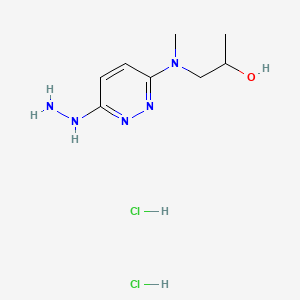
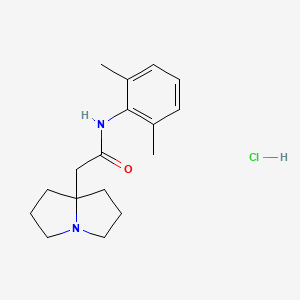
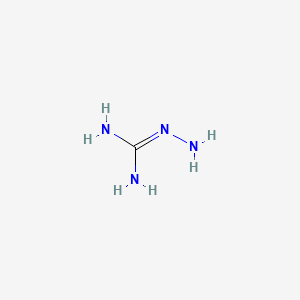

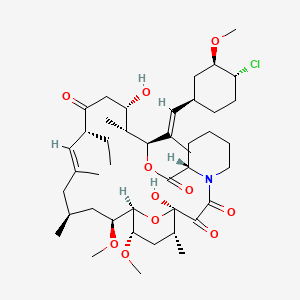

![[1]Benzothieno[3,2-d]pyrimidin-4(3H)-one, 2-[(dimethylamino)methyl]-8-(4-hydroxyphenyl)-](/img/structure/B1677885.png)
